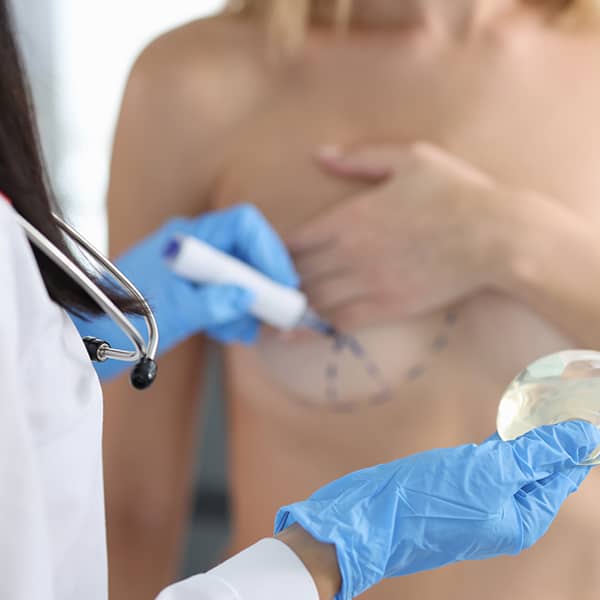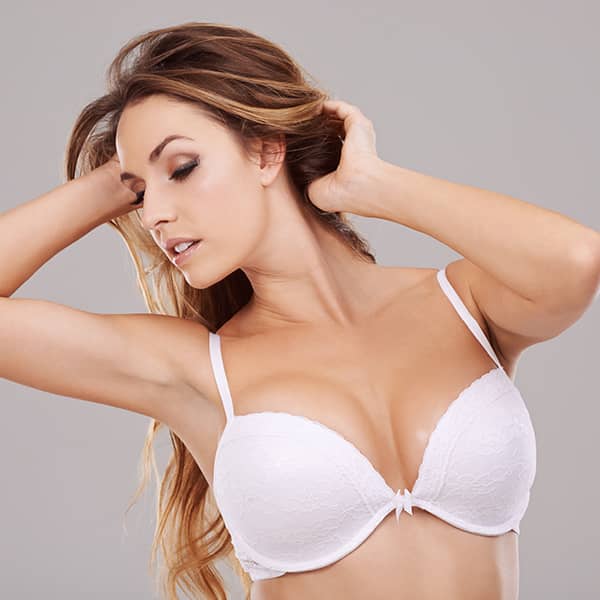Breast Augmentation
Breast augmentation is a cosmetic surgery procedure that involves increasing the size and/or altering the shape of the breasts. Breast implants are commonly used to achieve these results.
Breast augmentation has been around since the late 1800s, with early procedures involving injecting substances like paraffin oil and silicone into the breasts. In 1962, the first modern breast augmentation surgery was performed using silicone gel implants. Breast implants are now made from a variety of materials, including saline (saltwater), silicone, and alternative composites. Breast augmentation surgery has come a long way since its earliest days. It is one of the most popular cosmetic surgery procedures in the United States, with more than 300,000 women undergoing surgery each year.
If you have any questions about a breast augmentation in Bakersfield, call our office at (661) 808-4070 or fill out the contact form to schedule your consultation with Dr. Freeman today.

Should I Get Implants?
There are many reasons why women may choose to undergo breast augmentation surgery. Some women feel that their breasts are too small or uneven in size.
The most common reasons women seek breast augmentation are:
- To achieve a more aesthetically pleasing appearance
- Breast size and shape are often seen as a symbol of femininity, and larger breasts can help women feel more confident
- Breast augmentation can also be used to restore breast volume and shape after weight loss, pregnancy, or breastfeeding
(Note: Implants cannot correct severely drooping breasts. A breast lift may be required in addition to breast implants for this reason.)
How Long Do They Last?
Breast implants are not designed to be a lifetime product. The average lifespan of an implant is ten years, though they may need to be replaced or removed sooner in some cases. Breast implants may also rupture or leak over time, and you will likely need to undergo surgery to remove or replace the implant if this happens. For more detailed information about this please visit the official FDA breast Implants site.
Risks of Breast Augmentation
As with any surgical procedure, there are risks associated with breast augmentation. These include infection, bleeding, capsular contracture (scar tissue around the implant), and asymmetry.
While most women do not experience any complications from breast augmentation surgery, it’s important to be aware of the risks before undergoing the procedure.
Five points to keep in mind:
- Some women develop numbness or changes in nipple sensation following surgery. These symptoms usually fade over time but may become permanent in some patients.
- Breast implants may also interfere with mammogram screenings. When you go for a screening, be sure to let the technologist know that you have implants so that they can take appropriate measures.
- Breast implant associated-anaplastic large cell lymphoma (BIA-ALCL) can develop after a breast implant procedure.
- Occasionally an implant may leak (silent rupture), which can cause pain, changes in breast appearance, and implant deflation. If a saline implant ruptures, your body will safely absorb the saline. A periodic MRI or HD ultrasound is recommended to check implant integrity.
Breast implants are not guaranteed to last a lifetime, and you may need additional surgery to replace or remove them.
Types of Breast Implants
Breast implants come in a variety of shapes, sizes, and materials. The type of implant that is right for you will depend on your desired results, body type, and lifestyle. Here are some options you can discuss during your consultation process.
- Silicone Breast Implants: Silicone breast implants are filled with silicone gel. This gel feels similar to human fat and is often considered to offer a more natural look and feel. However, because silicone implants are pre-filled, they tend to be slightly more expensive than saline implants. Additionally, if a silicone implant ruptures, it can be difficult to detect.
- Saline Breast Implants: Saline breast implants are filled with sterile saline water. Because they are not pre-filled, the surgical incision is generally smaller. These implants tend to be less expensive than silicone implants, but saline implants may cause the breasts to feel less natural.
- Gummy Bear Breast Implant: Gummy bear implants are a type of silicone implant that is filled with a cohesive gel. This gel is thick and sticky hence the nickname “gummy bear.” These implants are often used for patients who want a more natural look and feel but are concerned about the risks associated with traditional silicone implants because they are less likely to leak or rupture.
- Textured breast implants: Breast implants can also have a smooth or textured surface. Textured implants are less likely to move around, which may decrease the risk of implant rippling.
- Smooth Breast implants: Smooth breast implants are the most common implant and offer a natural look and feel. However, there is a higher risk of implant rippling because they can move around.
Implant Sizes and Shapes
Breast implants are measured in cubic centimeters (ccs), and the average implant size is between 300-400 ccs. However, your surgeon will work with you to choose an implant size proportional to your body and achieves your desired results.
Breast implants come in two shapes: round and teardrop. Round implants offer more fullness at the top of the breasts, while teardrop implants offer a more natural look.

The Process
Choosing to undergo breast augmentation surgery is a very personal decision. Be sure to do your research and choose a board-certified plastic surgeon that you feel comfortable with.
During your consultation, ask questions about the surgeon’s experience, training, and before and after photos. You should also inquire about the type of implants they use and ask to see samples. Speak to your doctor about anesthesia options and the benefits and risks.
Preparing For Surgery
You will likely be asked to have a mammogram to check for abnormalities. You will also need to stop taking medications, such as blood thinners and non-steroidal anti-inflammatories. Be sure to follow your surgeon’s instructions carefully. Depending on your individual needs, your surgery may take place in our office, a surgery center, or a hospital.
The Procedure
During the procedure, your surgeon will make an incision in the crease beneath your breast, around your areola, or in your armpit. The type of incision will depend on factors such as implant type and size, as well as your unique anatomy.
Your surgeon will create a pocket for the implant and insert it. The incision will be closed with sutures. In some cases, the surgeon may also place drainage tubes beneath the skin to collect excess fluid. The drains are usually removed within a few days.
There are three types of incisions
- Inframammary incision: This incision is made in the crease beneath your breast. It offers good access to the implants and allows your surgeon to place them under your chest muscle for added support.
- Periareolar incision: This type of incision is made around the edge of your areola. It allows your surgeon to place the implants under your chest muscle for added support.
Transaxillary incision: This incision is made in your armpit. It offers minimal scarring but may be more difficult to place the implants accurately.
Recovery
After surgery, you will likely feel groggy from the anesthesia. You will be given a surgical bra to wear and told to sleep on your back with your head elevated. It is important to avoid lying flat on your back for the first few nights after surgery to reduce the risk of bleeding and swelling.
Be sure to follow your surgeon’s instructions for post-operative care, including taking pain medication and wearing your surgical bra. Most people take approximately two weeks off from work to recover, and you should avoid strenuous activity for at least six weeks.
Some things to keep in mind
- The sutures will be removed in a week to ten days following surgery, but the swelling may take three to five weeks to subside.
- For at least six weeks following breast augmentation, your scars will be firm and pink. Your scars will fade after a couple of months, but they will never entirely disappear.
You may experience some pain and soreness, as well as bruising and swelling. These side effects are normal and will subside over time.

Breast Augmentation in Bakersfield
Breast augmentation surgery can be a life-changing experience. Not only can it improve your appearance, but it can also boost your self-confidence. If you are ready to take the next step and are looking for a breast augmentation in Bakersfield, contact our office at (661) 808-4070 or fill out the contact form to schedule your consultation with Dr. Freeman today.
